Executive Summary
Amid a landscape that has been dominated for nearly a decade by a select group of financial planning software heavyweights – MoneyGuidePro, Naviplan, and eMoney – newcomer RightCapital first launched in 2015 at the XY Planning Network conference. With an eye towards providing a simpler and easier-to-use interface and presenting solutions to clients in easy-to-understand reports, RightCapital (perhaps undeservedly) was labeled as a “light” financial planning software solution by industry publications. But in reality, RightCapital not only fills gaps left by other planning software providers around the intersection of retirement decumulation, tax planning, and Roth conversion strategies – that show, in dollars, the tangible value that financial advisors bring to the table – but also allows advisors to work with largely unserved next-generation client segments with its student loan planning capabilities, and to produce financial plans faster with its more collaborative planning capabilities. All of which has helped RightCapital in just 5 years since launch to jump to 4th in market share amongst financial planning software and, according to the latest Kitces Research study, see the biggest gains in market share for both broker-dealers and RIAs in the past two years.
In the guest post, Craig Iskowitz – CEO and founder of Ezra Group, a financial technology consulting firm – provides an in-depth software review of RightCapital, covering its features and benefits, interface, modules, client deliverables, and pricing.
In a crowded financial planning software marketplace, RightCapital differentiates itself by allowing advisors to help their clients with:
- Real-time collaborative planning around retirement planning and goal setting/scenarios by using “levers” to immediately show the dollar impact of different strategies (thus showing the tangible value of the advisor and fostering greater engagement),
- The tax impact of various decumulation strategies (whether proportional or sequential across different types of accounts) and the value of proactive tax planning through Roth conversions (for which RightCapital has been the only full-scale financial planning program in recent years to offer such in-depth capability),
- Detailed cashflow reporting and asset allocation modeling (thanks to their state-of-the-art calculation engine, which allows advisors to quickly flip through analytics tabs), and
- Using either a goals-based or cashflow-based planning approach depending on the client’s personal circumstances and advisor preferences.
RightCapital also offers a Social Security optimization and Student Loan planning modules, as well as accumulation planning and estate planning capabilities, though none of those features necessarily help the software stand out from other full-stack financial planning software providers or standalone vendors providing similar tools. And notably, while RightCapital has expanded its suite of available integrations with popular CRMs, reporting tools, and custodians, it still doesn’t have the breadth of integrations when compared to other providers (which means it’s important to check upfront if it integrates for any particular advisor’s tech stack).
Ultimately, most comprehensive financial planning software is ‘comprehensive’, which means ironically all the available solutions do so much it’s often difficult to differentiate at the margins which is really best at what. In the context of RightCapital, there are several areas that do stand out against its competitors, particularly when it comes to an attractive and intuitive user interface, real-time collaborative planning (and its speed to do calculations, which matters when clients are watching in real-time!), and the ability to choose either a goal-based or cashflow-based planning approach. However, RightCapital’s key differentiator is its detailed and tax-sensitive retirement distribution planning, which helps foster engagement between client and advisor, and importantly, demonstrates the actual dollar value that an advisor can offer... particularly in an environment where advisors are pressured to justify their fees. RightCapital may not offer all the robustness (or complexity) of eMoney, Naviplan, or MoneyTree, in certain areas, but it does provide powerful capabilities (especially for tax-savvy advisors) at an attractive price in a competitive marketplace.
Today, RightCapital has gained enough market share to be included in our review of financial planning tools. According to the latest Kitces Research study, RightCapital ranked 4th based on the 2019 market share statistics for financial planning software tools.
RightCapital has been labeled “financial planning – light but not too light” by industry publications. However, our analysis reveals that RightCapital is increasingly filling a void in planning software highlighted previously on this blog – software that accurately models retirement decumulation planning (as opposed to the traditional approach of planning for accumulation clients) – and delivers sophisticated retirement distribution analyses in an easy to understand manner for clients. After a thorough review of the application, the phrase “light but not too light” does not accurately describe the depth and complexity that can be delivered through this tool.
In fact, one of the most touted features of RightCapital is the withdrawal strategy analysis, which shows the dollar value of converting clients from a proportional withdrawal strategy across all accounts, to a tax-sensitive withdrawal strategy that considers the sequencing of which accounts (taxable, tax-deferred, and Roth) are spent down and when. This same module shows the tax benefit in $$$ of converting clients to a Roth IRA. These seemingly simple illustrations, backed by complex algorithms, demonstrate the tangible benefit of working with a financial advisor.
RightCapital also has other unique features, including being the only financial planning software with in-depth student loan planning capabilities built-in (albeit still not as deep as standalone student loan planning software solutions for advisors). This is appealing to both younger clients who carry student loan debt, and even older clients concerned about their children affording or living with student loan debt, looking to better manage this often significant liability.
And notably, in a world where many advisors are still divided on the relative benefits of cash-flow-based versus goals-based planning – with adherents on either side – RightCapital deftly avoids choosing sides by simply making the selection of cash-flow- or goals-based a toggle choice that advisors can select, based on what’s appropriate for the client, one plan at a time.
RightCapital User Interface: Clean And Intuitive
RightCapital bills itself as a “next-generation financial planning application”, and its cutting-edge calculation engine does deliver super-fast results (i.e., calculations literally load very quickly on the screen, unlike some other planning software tools where it takes many seconds with a notable pause for the results to appear).
The firm also sets itself apart from its competitors with the simplicity and flexibility of its interface. Intuitive navigation and the option to make changes to a plan on a single screen, to engage in more interactive and collaborative planning with clients on the spot, make it a strong contender for advisors looking to present complicated financial planning results to their clients in a streamlined and simplified format. (See the following section Retirement Planning and Goals for an example of this capability.)
RightCapital Retirement Planning: Strong Flexibility And Exceptional Presentation
RightCapital stands out due to its capability to present the plan to clients live, directly from the software (as opposed to printing out the plan output to deliver to clients in a meeting). Its highly intuitive display makes the application an excellent presentation and communication tool for advisors.
For example, the retirement analysis screen below shows the probability of success of a client’s proposed and current retirement plans. Then, at the bottom of the screen are preselected “levers.” By selecting a series of levers (asset allocation strategy, time horizon, annuity income, etc.), in collaboration with the client, advisors can immediately display the dollar impact of changing the retirement strategy. The advisor (or the client themselves) adjusts the levers and shows the clients the results (probability of achieving the plan, income stability, and plan comparisons) creating a powerful presentation tool, and demonstrating the actual “value” of the advisor in terms of $$$ saved. Not only is does this approach produce tangible value, but it also fosters greater engagement between client and advisor.
The appeal of this kind of interface is not only that it is easy to use and intuitive, but advisors do not need to go back to settings to make plan adjustments, and there is no toggling between screens… saving time, while also enabling deeper conversations with clients. This is a significant advantage compared to other financial planning tools, and the ease with which advisors are able to adjust and present modified plans and scenarios should not be underestimated.
RightCapital’s Key Differentiator: Tax-Sensitive Decumulation Strategies For Retirees
Another standout feature of RightCapital’s software lies in its focus on the decumulation or the distribution side of the retirement equation. The application has a distribution module which models retirement liquidation/distribution strategies by allowing advisors to switch between proportional withdrawals across all types of accounts versus sequential withdrawal strategies (where dollars are drawn in a more tax-efficient manner, such as starting with taxable, then pre-tax, and then finally tax-free accounts.)
The financial impact of adding or converting to a Roth IRA, including the option to engage in systematic partial Roth conversions to fill up lower tax brackets repeatedly over multiple years, can be displayed visually. This module allows advisors to demonstrate value with ongoing proactive tax planning efforts over time. And notably, RightCapital is the only full-scale financial planning program that offers the ability to model this particular popular tax planning strategy for retirees, giving them distinct advantages over other applications for tax-savvy advisors.
The illustration below shows how this functionality can be used to quantify the advisor’s value to the client. In this instance, the advisor saved the client $868,275 in taxes over time, simply by changing the withdrawal strategy from proportional to sequential and engaging in partial Roth conversions to fill up the bottom tax bracket.
RightCapital’s Social Security Optimization And Scenario Analysis
Another feature worth mentioning is RightCapital’s Social Security optimization module, which permits advisors to show their clients the dollar impact of different retirement age options against the optimal strategy. The module predicts the maximum benefits based on life expectancy and indicates a breakeven point as to how long a person would have to live to begin seeing the breakeven point on a particular strategy. Though notably, RightCapital’s Social Security optimization comparisons only use a limited subset of (common) claiming ages, and not all the possible combinations, and do not appear to fully consider integrated claiming strategies for couples that consider the full impact of spousal and the potential step-up for widow(er)’s benefits for a surviving spouse, making it more limited than available standalone Social Security optimization tools like SS Analyzer, Maximize My Social Security, or Social Security Timing.
On the accumulation side, RightCapital is undifferentiated from other offerings and is not as robust as MoneyGuide’s goals-based planning tool when it comes to guiding the client through the process.
At its core, RightCapital offers a detailed Monte Carlo simulation that simplifies retirement accumulation scenario comparisons using different assumptions. Advisors can quickly adjust the plans via the levers found at the bottom of the screen. In addition, advisors can easily change scenarios (either predetermined or custom-built) by selecting from the dropdown box in the upper right corner. Other RightCapital goals-based planning features include the probability of success analytics and confidence ratings typically associated with Monte Carlo accumulation plans.
By contrast, MoneyGuide focuses more on guiding clients and advisors through the goal-setting process itself, recognizing that not all clients are clear on exactly what their accumulation goals should be without exploring the possibilities in the first place. With MoneyGuide, advisors ask clients to slot goals into needs, wants, and wishes which helps to prioritize client goals, while RightCapital simply selects (otherwise-equally-weighted) goals to consider. MoneyGuide also walks clients through a section that speaks to concerns (what keeps you up at night?), again meant to deepen the conversation and highlight gaps in the client’s current financial plan, beyond just quantitatively analyzing it as RightCapital does.
While MoneyGuide may have more goals-based features and nuances, RightCapital certainly checks off all the boxes needed to provide clients with a solid goals-based plan, though, and delivers more flexibility in its capabilities to do so.
Most notably, through RightCapital, advisors can choose which type of plan to generate: goals-based, or cash-flow based - based on client needs. The difference, in essence, is that goals-based plans only include the cash flows (e.g., savings or withdrawals) specifically tied to the articulated goals, while cash-flow-based plans consider the household’s entire cash flow (all the dollars in, out, and the net difference saved or spent), which allows for more granular analysis but can also take more time to analyze and produce.
In the end, advisors must choose how they want to interface with clients, and which approach best serves their needs. But in the past, most advisors had to make that choice by planning software itself – e.g., goals-based with MoneyGuide, or cash-flow-based with eMoney or NaviPlan – while RightCapital simply makes it a toggle switch for advisors to do whichever they prefer, within one solution, on a client-by-client basis.
RightCapital’s Estate Planning Capabilities
While estate planning is not RightCapital’s forte, the application does offer basic functionality, although it is not as comprehensive as that of eMoney Advisor.
RightCapital’s estate flow screen shows the flow of assets to heirs. But, unlike eMoney, which has charts that allow the advisor to drill down for further details, RightCapital’s estate flow is static. eMoney also allows advisors to review the estate cash flow for any given year, by simply selecting the appropriate time period from a dropdown box, to understand how estate tax exposure and the distribution of assets may change over time, whereas RightCapital simply shows a current point-in-time estate flow.
Similarly, both RightCapital and eMoney let advisors compare various common estate planning strategies, such as an Irrevocable Life Insurance Trust (ILIT), Charitable Remainder Trust (CRT), and the classic A/B trust (also known as Credit Shelter Trust or CST planning). However, only eMoney has a screen that models survivor income from the inherited assets after the decent passes away.
RightCapital Speedy Calculation Sets It Apart
RightCapital offers all the basic reporting capabilities found with other financial planning software vendors, but one big differentiator is its calculation engine, which is built on newer technology and helps RightCapital function at lightning-fast speed. In addition, the app provides (for those who select to use it) detailed cash flow reporting that itemizes all the components of the financial plan such as college debt, social security, withdrawals, insurance payments, etc.
RightCapital also has an asset allocation module that will compare a series of asset allocation changes, and the impact those changes have on the client’s plan. Advisors have the option of using pre-populated assumptions and models, or they can customize their own capital market assumptions, such as volatility or inflation rates, and build out their own asset allocation models.
RightCapital’s investment analytics dashboard allows advisors to easily compare the client’s current allocation against targeted asset allocation, sector and style analysis, concentration levels, and tax allocations, along with the changes needed to achieve the plan. Unlike other apps, and advisor can easily flip through the analytics simply by toggling through the tabs at the top of the screen.
RightCapital’s Client Portal, Data-Gathering, And Client Tasking Tools
The RightCapital client portal offers clients the same visibility as the advisor. Advisors can approve whether clients will have access to the portal, and then select which modules or analytical tools they want clients to access, by going through a checklist of the available options. In turn, clients granted access can be assigned to one of three levels: read-only, adjust but no save, or the ability to adjust and save the action items separately for discussion purposes with advisors. Clients are able to save scenarios without overwriting the existing assumptions and corresponding scenarios.
RightCapital’s client portal can also be used to facilitate data gathering, with advisors able to specify what types of data, such as household, income, goals, expenses, and tax data, their client will enter into the application, via a card system. Clients also have access to a vault for document storage which is a standard offering of most financial planning tools.
A popular function of RightCapital for advisors who work with clients on an ongoing (and not just one-time standalone planning) basis is the ability to detail client financial planning tasks, which can be set via the RightCapital task manager, allowing advisors to dynamically schedule tasks for clients with deadlines such as signing documents or submitting paperwork. Clients will receive an automated reminder email, at some future date, informing them of the upcoming task due date. This functionality saves time for advisors who may otherwise need to correspond with clients about their tasks and action times and eliminates the need for purchasing additional software such as Knudge to fill the gap or trying to jury-rig client task communication into a CRM system’s internal task management capabilities. However, this feature is not unique as other financial planning software tools, such as eMoney, also provide client task management functionality.
RightCapital’s portal provides many of the basics within the baseline pricing. However, access to data aggregation, and budgeting/spending analytics, are only offered through upgraded versions of the software. (See the pricing section that follows.) And overall, while RightCapital’s portal (with account aggregation) does provide a reasonable core financial planning interface for clients to track their goals, progress, and overall household finances, with greater depth than MoneyGuide, eMoney’s portal continues to be held out as the gold standard for advisors or enterprises looking to provide clients with access to a Facebook-like overview page, a summary of goals, spending and budgeting data, and investments (including access to transactions). Of course, the increased functionality with eMoney also comes at an additional cost (of roughly $1,900/year over its standard version).
RightCapital Third-Party Integrations, Data Aggregations, And APIs
Over the last few years, RightCapital has been criticized for its lack of integrations, which has been tended to with a growing list of integration partners, and today bears a solid roster of 31 integrations, which is comparable to eMoney’s, but lags in comparison to MoneyGuide which leads with 72 integration partners.
Of course, for any particular advisor, it’s not the number of integrations that matter, but whether the software integrates with the right partners that the advisor uses. A partial list of key RightCapital integrations includes CRMs (Redtail, Wealthbox), performance reporting tools (Orion, Black Diamond, Albridge, Advyzon, Blueleaf), custodians (TD Ameritrade, Schwab, Pershing, Fidelity, Folio Institutional, etc.), and the risk assessment tool Riskalyze. But a major gap, particularly for larger advisory firms, is the failure to integrate with Salesforce (common in the financial services enterprise space), though the lack of a Salesforce integration amongst AdvisorTech vendors is not uncommon (due to its integration complexity and detailed integration customization demands).
As noted earlier, RightCapital’s Premium and Platinum plans offer (at an additional price) account aggregation (via Yodlee). In addition, clients can link their bank accounts and credit cards for spending and budgeting, as well as any externally held investment accounts. This allows advisors to track aggregated data over time, portraying an updated picture of the client's financial situation. Advisors also have the option of manually adding specific investments, stock plans, loans, or other types of accounts not captured elsewhere.
Finally, RightCapital offers APIs that major brokerage and advisory firms can use to integrate the application, and RightCapital’s fast calculation engine, into their own dashboard and client-facing systems. This has proven to be popular among large enterprises that invest heavily in their own technology capabilities, such as Commonwealth Financial Network.
Overall, while it was a challenge in the past, we no longer view RightCapital’s list of integrations as lacking when compared to other offerings. However, the firm would do well to continue to build out this functionality. For example, other financial planning tools integrate with a wider variety of vendors including Hidden Levers, Oranj, Addepar, SS&C, Asset-Map, and Quovo.
RightCapital Pricing: How Much Does RightCapital Cost?
Price is important when comparing financial planning software, though pricing fluidity (as vendors do change their pricing with some regularity) makes it difficult to compare the value of various financial planning vendor packages.
In general, pricing structures for financial planning software have evolved in recent years from a one-size-fits-all approach to a tiered approach based on feature sets, including a baseline Basic option (usually roughly $1,000 - $1,500 per user per year), along with upgraded versions or specialized modules that may be 2X to 3X the price or more.
For instance, popular providers such as eMoney and MoneyGuide now offer add-on planning modules for an additional fee. eMoney offers baseline access to Foundational Planning, a goals-based planning module, and MoneyGuide offers access to MyBlocks, themed planning modules. In turn, eMoney then has a “Pro” tier with Advanced Planning, and MoneyGuide offers its Elite tier with more sophisticated retirement distribution planning.
In the case of RightCapital, there are three different versions of its financial planning software – Basic, Premium, and Platinum. Basic pricing lists at $1,500 and includes the core of retirement income, insurance and college planning modules, a document vault, and a client-facing mobile app. The upgraded Premium package is priced at $1,800 and includes data aggregation, and cash flow budgeting tools (including RightCapital’s automated “Smart” categorization feature). Finally, the Platinum package includes more capabilities to customize asset classes and other return parameters, along with more team collaboration features. Notably, though, Right Capital does not provide a price for its Platinum tier, which it requires to be negotiated directly with the vendor.
Enterprise licenses are also available for 50 or more licenses and/or API solutions. (Though we did not demo the enterprise version of the software for this review.)
Ultimately, while planning software costs do differ depending on the vendor, discount practices, and feature set, it is notable that the total cost of financial planning solutions remains relatively small when compared to many other AdvisorTech solutions.
RightCapital’s strength lies in its intuitive, user-friendly display, in-person collaborative planning capabilities, and lightning-fast responsiveness when loading and engaging in calculations, and so it gets high praise for user experience. Yet notwithstanding its ‘simple’ interface, RightCapital is actually one of the most robust planning packages when it comes to detailed and tax-sensitive retirement distribution planning. We believe that RightCapital has found the balance between conducting complex analytics and delivering them via an easily understood, dynamic set of illustrations. Advisors are advised to look beyond the catchphrase “light but not too light”.
In addition, the decumulation module includes powerful analytics that illustrate the $$ benefits of switching withdrawal strategies, instantly validating the “value” of the advisor in a world where advisors increasingly feel the pressure to validate their fees.
However, outside of its core areas – planning for younger clients with budgeting and cash flow tools, and planning for decumulation with retirees – the application is not as comprehensive as other leading solutions such as eMoney for ‘classic’ accumulators and also ultra-high-net-worth clients, lacking estate planning and the ‘endless’ reporting options of competitors. Additionally, we believe other tools such as MoneyTree and NaviPlan provide better audit trails for their complex calculations (not that RightCapital’s are incorrect, but sophisticated clients often want to vet and understand where the numbers came from, in a way that RightCapital cannot always easily demonstrate).
However, RightCapital still does a great job of delivering complicated and powerful analyses in an easy to understand manner and seems to simplify what can sometimes be an overwhelming process and array of choices, all for a competitive price in the current planning software marketplace.




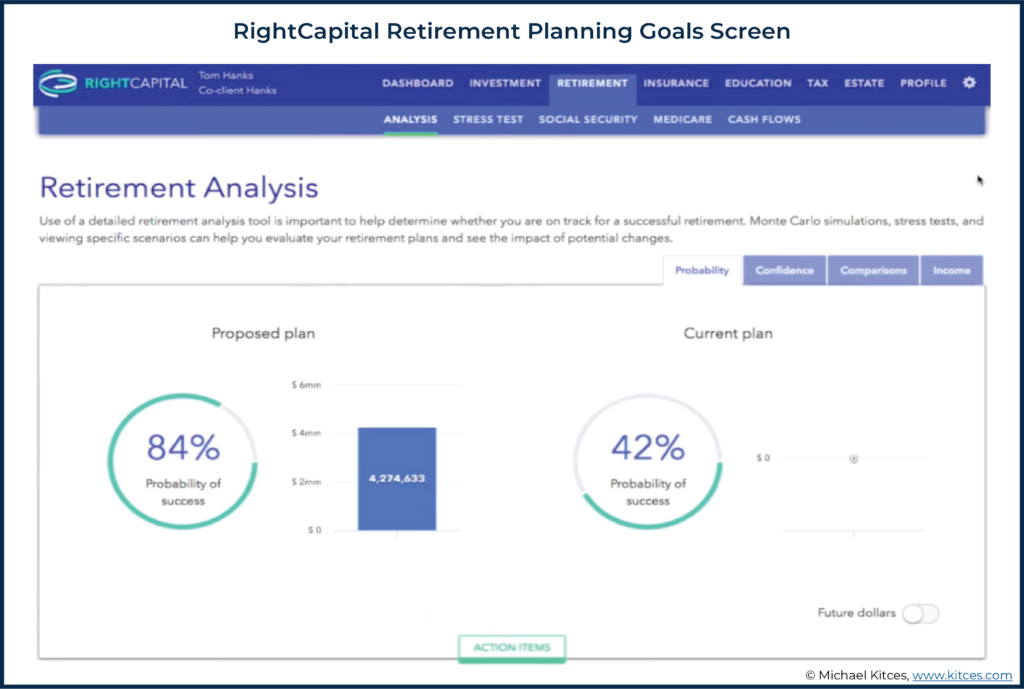
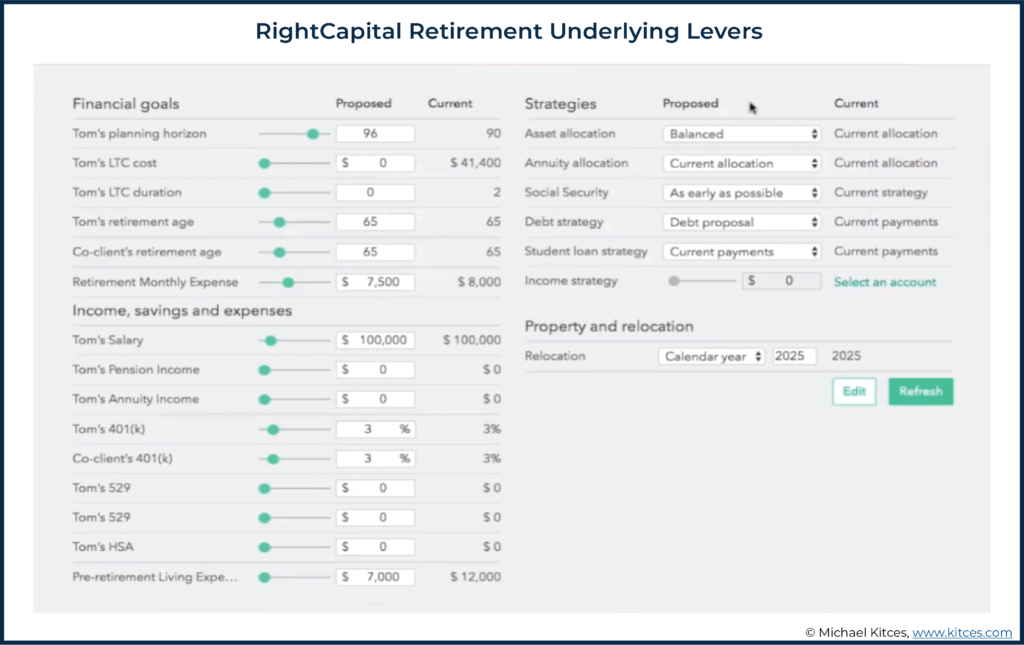
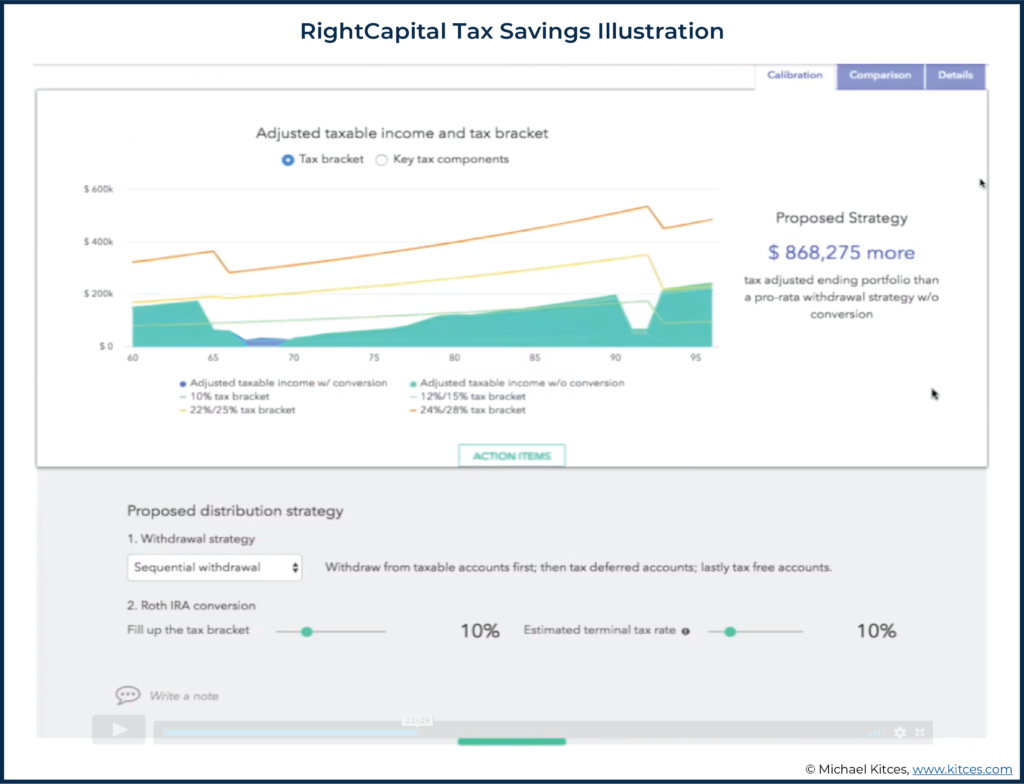
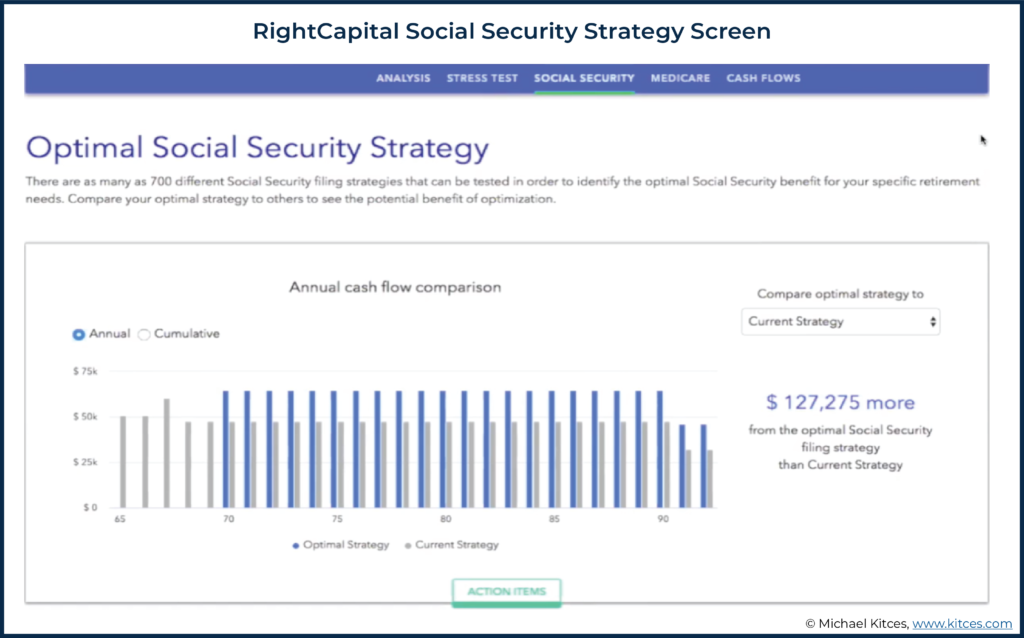
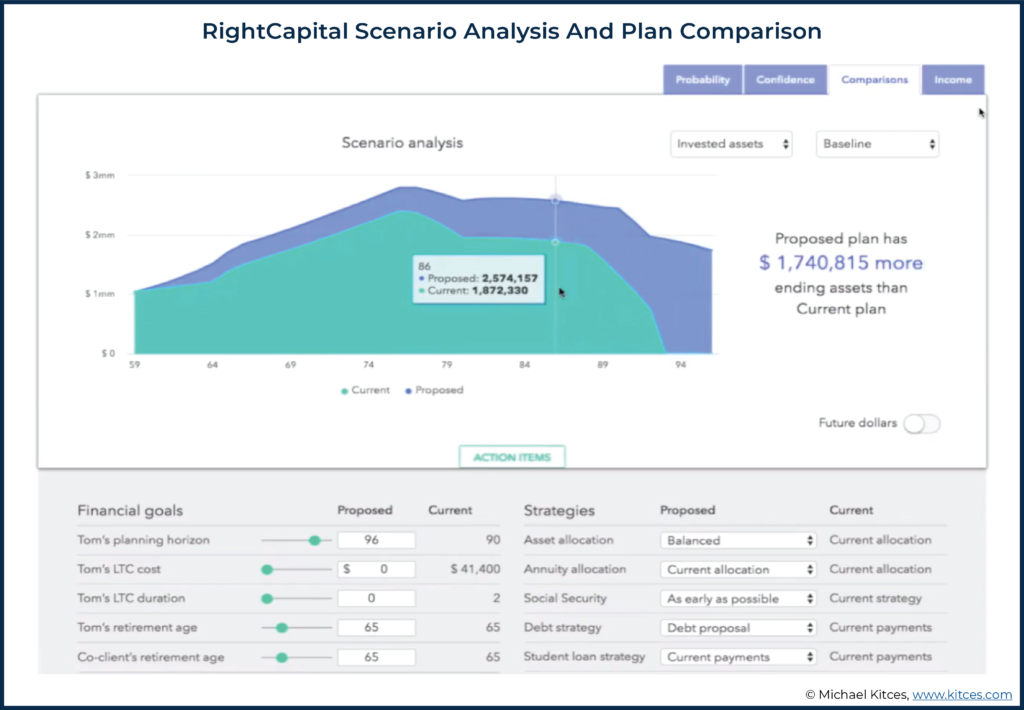
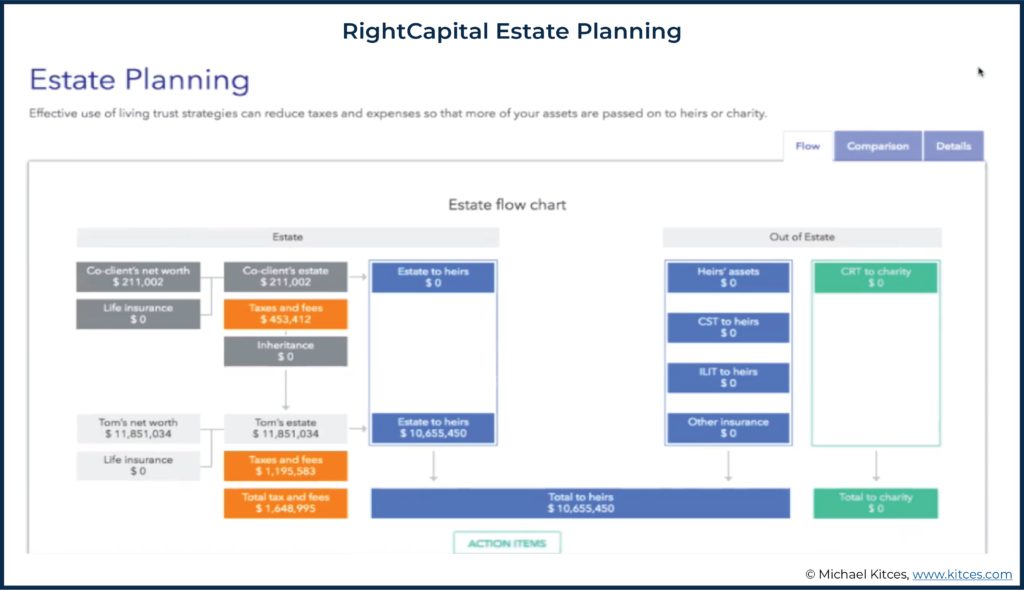
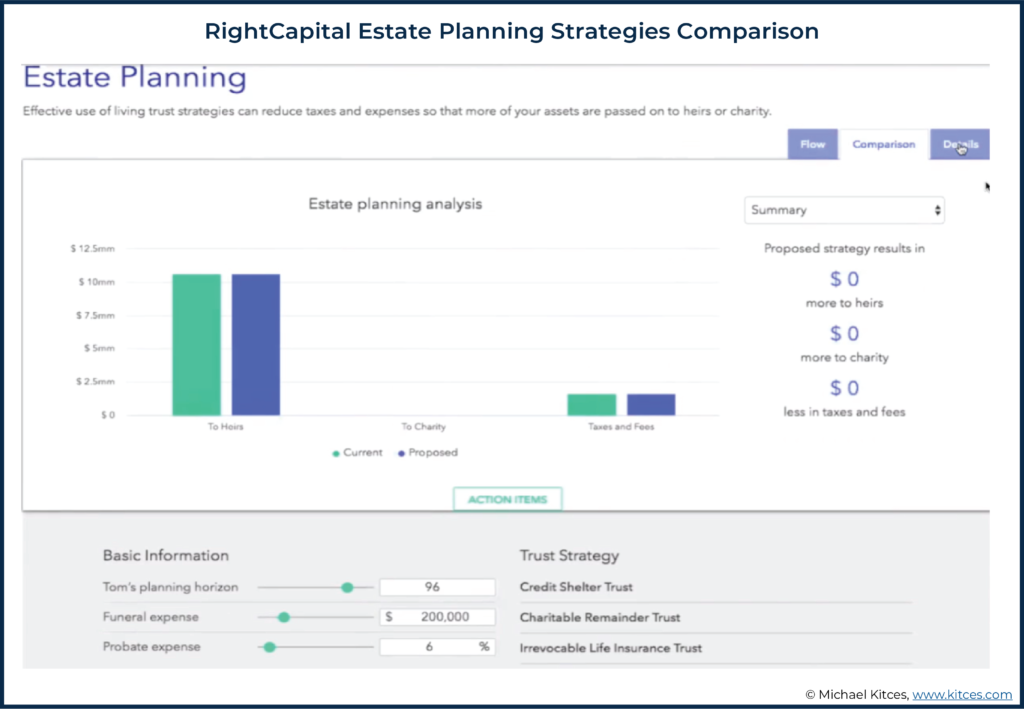
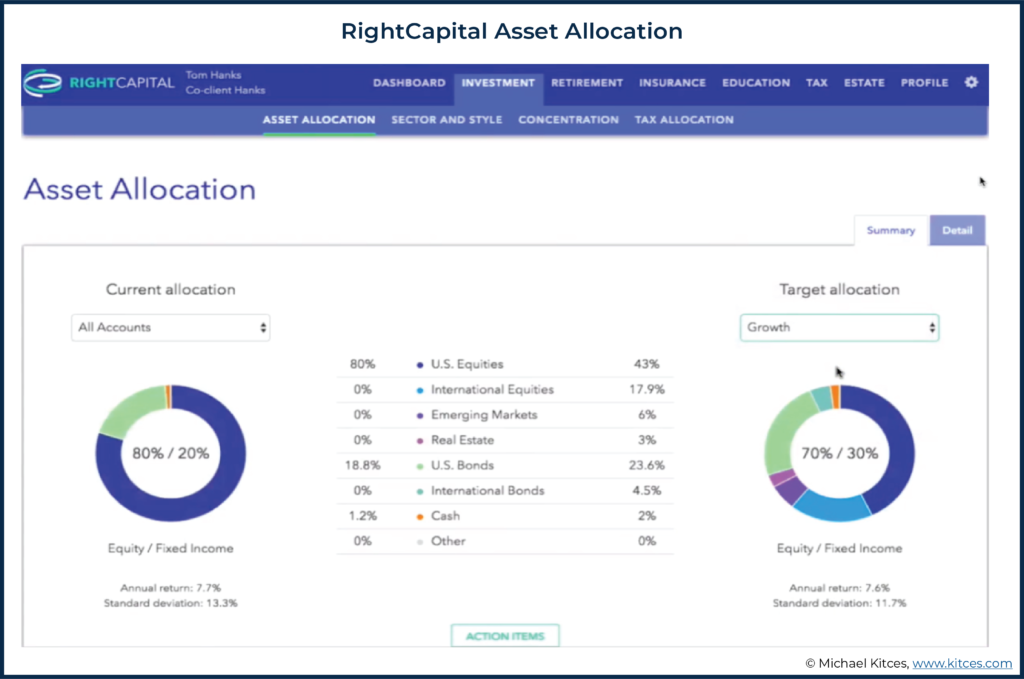
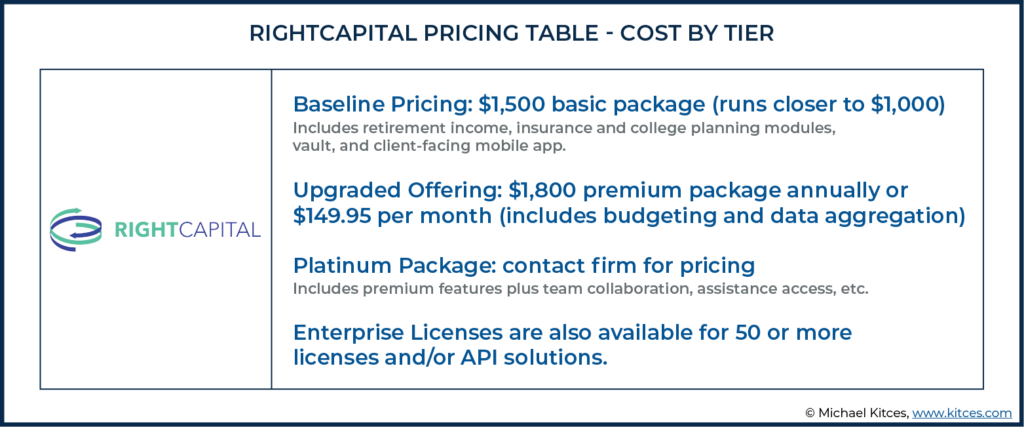



I have been using RightCapital for over a year now. The tax planning and visual presentation for clients really make it stand out for me. Being able to show clients how much they can save by going with a particular income plan, or Roth conversion, and the dollar amount they could save is so valuable. As an advisor I can put a dollar amount to the benefit I am adding with the plan.
Visually the clients seem to get the plan a lot more vs. when I would present with Emoney. The graphs are great, the stress tests are also great whenever clients have fears over retiring during a market downturn, higher taxes in the future, even social security reduction.
Really good review of the program.
Tim,
Thanks for your comment!
Craig
In the article, it is said “the advisor saved the client $868,275 in taxes over time, simply by changing the withdrawal strategy from proportional to sequential and engaging in partial Roth conversions to fill up the bottom tax bracket.”
I love at lot about the software, but since those savings are NOT in today’s dollars, the advisor is unfairly taking credit for “inflation”!! That is something I have asked RightCapital to fix because it OVERSTATES the advisors’ value. It would be much better to show those savings in today’s dollars.
I have also put in this request with Right Capital. Hopefully they work on it!
William,
Thanks for your comment. You make an excellent point. We should have noted that in our review.
Craig
Our firm did an extended free trial with RightCapital. We especially liked the Roth conversion and tax capabilities as well as the sleek reports and data entry. However, we ultimately decided to stick with NaviPlan for one key reason: the life and LTC analysis in RightCapital are based on straight line returns but use the same rates of return for each asset class as the Monte Carlo calculations for the retirement analysis. The result of this is that RightCapital rarely recommends that a client needs life or LTC insurance. We tested this for some clients who most definitely need significant amounts of life or LTC insurance and the software did not report a need because the investment returns are assumed to be so high.
Have any RightCapital users also encountered this issue or found a way around this limitation? We tested the software extensively and did not see a way around it
Chris,
Thanks for your comment. Hopefully, we will hear from some other advisors who have found a workaround for this issue.
Craig
Right Capital’s review states
“The application has a distribution module which models retirement liquidation/distribution strategies by allowing advisors to switch between proportional withdrawals across all types of accounts versus sequential withdrawal strategies”
The flaw here is that if the advisor picks the wrong schedule of withdrawals from the tax-deferred, Roth IRA, and taxable accounts the tax consequences can be adverse.
The free, Internet available retirement optimizer http://www.i-orp.com computes a true optimal solution by optimizing withdrawals as it minimizing taxes while it is maximizing asset return compounding. Balancing these two conflicting goals is what optimization is all about. Not even the cleverest advisor will improve on ORP’s withdrawal schedule.
James,
Thanks for your comment! Optimization is a complicated process and we’ve seen it implemented a hundred different ways. Balancing multiple goals by running hundreds or thousands of scenarios with different parameters to find the best solution is what we would call optimization. Let’s hope RC implements something like this in the future.
Craig
James,
Indeed, I view RightCapital (and most financial planning software) as “modeling” outcomes, but not actually “optimizing” them (notwithstanding the marketing collateral of some). Modeling outcomes means the advisor makes the inputs (and/or tries to figure out ‘optimal’ ones), and the software simply models how that turns out. (Change the scenario/inputs and get a better outcome, and that one’s better. Wash/rinse/repeat.) That’s different than a true optimization engine that actually determines FOR the advisor (or consumer) what the optimal plan IS by doing that iterative work (or solving formulaically) on behalf of the advisor.
We generally focus on advisor tools and not those that are direct to consumer, but will look at potentially adding i-orp.com to our list of tools that we analyze someday! Appreciate the suggestion!
– Michael
You are the creator of this I see. Bold statement if the adviser picks the wrong…and your system is the only “true” …hmmmm. Your system does not allow for alternative tax favored assets like munis, cash value life insurance, CRT’s, and others that can generate tax free income. I saw in the data / technical driven output that you also have RMD’s but have no way to offer QCD’s which may lower thresholds to “optimize” taking income from other buckets. What about client’s intent such as legacy and charitable. I find most have these as more important goals than income and if planned correctly, can offset “taxes.”
You state optimize distribution, returns, and investment return is a benefit of your software. However, you have no way to consider the benefits of tax loss harvesting or sale of certain assets to offset taxes. What about charitable offsets? What using about CLT’s to get a PV tax deduction of the next 10 years of giving? You cannot truly “optimize” taxes in a retirement plan without the consideration of these and other factors.
To truly optimize, we must know our client and their objectives which is far more of an “art” over a “science” of computer simulation. No “software” can replace what a “competent” adviser can do…perhaps when AI comes out and is truly like a “Lt Data” from Star Trek. However, until that time, computers cannot optimize the best way to provide what people want based on their unique perspective, quirks, and goals. I am sure your system has “value”. You may gather more bees by stating the “benefit” rather than trying to position advisers as not being valuable. You do get what you pay for in this world and free is often a good indication of delivered value.
Been using Right Capital since March 2018. LOVE IT! LOVE IT! LOVE IT! The tax stuff blows away anything I’ve ever seen. And for me, that’s what matters. It’s simply beyond compare.
Josh,
Thanks for your comment!
Craig
I have used two of the other major competitors of Right Capital and my experience is that RC is by FAR the best at supporting advisors – you can get a near instantaneous response to support queries, they make frequent enhancements to the application, have almost no bugs, and have extensive webinars and support mechanisms. In addition they take all requests for enhancements seriously and often have a request implemented by the end of the week. I consider the support invaluable.
Jean,
Thanks for your comment!
Craig
I’ve used RC for the past 2 1/2 years since going independent. LOVE the software! The tax projections and Roth conversion projections are better than any other tools. Very easy to use and client-friendly. They have also continued to make improvements based on input from advisors.
Eric,
Thanks for your comment!
Craig
Having been in the industry for 20+ years with multiple firms – I have had the opportunity to use many financial planning programs. RC has been by far the most client engaging tool I have used. The modern design and easy to understand modules make it a true hit with clients. Shuang and his team have been very open to enhancement suggestions and have consistently delivered on them in a timely manner. Congrats to the RC team!
Ryan,
Thanks for your comment!
Craig
I have been using Rightcapital for awhile and I will echo the comments from other advisors below regarding the planning and strong tax chops. The difference between what they are doing versus others is they are listening to their users. I don’t care if you are marginally better as clients have no idea whether you are using Rightcap, Emoney or a whole host of other options. The update of the tasks feature has the potential to be a game changer and I would suspect they get into Mindmapping next (an Asset Map strength). This would inevitably lead to advisors cutting down on their tech stack and streamline more processes. Shuang and team understand that planning software should be used as an engagement tool while communicating an advisors value.
Aaron,
Thanks for your comment!
Craig
I have had the chance to use RC for about two years now and it’s growth as a software over that period is truly impressive. I think providers, particularly eMoney, need to adopt many of RC advanced tax planning features (Roth conversions, cough, cough).
However, I’ve been reading Kitces for a very long time and this is the first article I feel smacks with conflicts of interest and is more of a sales pitch then anything. I’m not looking to discredit the author (he has done incredible work for our industry) but I perceive that a disclosure of the relationships (financial or otherwise) between Kitces, XY Planning, and any other entity he is involved with, and RC is warranted.
Jack,
Thanks for your comment. Just to clear things up, I have no financial or other relationship with RightCapital. I run my own consulting firm, Ezra Group, which is completely separate from Kitces.com . I’m listed as a consulting partner here for firms that are looking for consulting projects. However, this has nothing to do with any software review we may write. Ezra Group receives no payments from vendors for reviewing products nor any sales commissions or any type of referral fees. We create content for our blog, Wealth Management Today as well as for Kitces.com , purely for marketing purposes.
Craig
Jack,
Appreciate the concern, and as Craig noted he wrote this as a Guest Post author for Kitces.com (it wasn’t from our team directly).
But just to be clear:
1) Kitces has no ongoing financial interest in or relationship with RightCapital. We did, early on, do a handful of 1-hour consulting engagements with RightCapital to incorporate some of our research in areas like how to model partial Roth conversions (which is now a popular feature of theirs!), but it was simply a few standalone consulting hours, and hasn’t occurred for several years now.
2) XY Planning Network has no financial interest in RightCapital (it’s simply a very large paying enterprise customer who writes a check like every paying user does).
3) None of my other businesses have any other financial interest in RightCapital.
Simply put, the review is positive because the software is executing well. It was the highest user-rated of any of the financial planning software we surveyed in our recent Kitces Research study. Not that the software is perfect – as Craig did highlight a number of areas of weakness, or at least where RightCapital does NOT shine – but the review was developed independently by Craig, and we don’t have any financial interest or conflict regarding RightCapital anyway (so even if it was generated by our team directly, I’d stand by its objectivity).
As a more general note, when there are companies that I have a financial relationship with, we do try to always include a note at the end of the article to recognize those financial relationships so readers are aware of the potential conflict of interest and evaluate the content accordingly. You may have seen a few of these at the end of select Monthly AdvisorTech recap articles (where we have commented on companies that I have a relationship to). But RightCapital isn’t one of them. 🙂
Hope that helps to clarify!
– Michael
Thank you for this article. Can you speak to RC’s ownership structure and what you see as its likely trajectory?
I’ve been using eMoney as my client portal/aggregator and MoneyGuide for projections but also have a few clients on RC to try it out. My main hesitation about moving exclusively to RC is that it is relatively new and I worry about it being sold or going under. I don’t want to put my clients or myself through the trouble of switching and then having to switch again soon thereafter.
Rob,
Thanks for your question. According to Crunchbase, RC is a private company that has raised over $6mm in funding. Their most recent was a Series A round. That’s all the information that is publicly available.
Best,
Craig
I wonder a few things.
First, any chance RC will add forecast for estate planning? Like eMoney? That tool is very useful, especially given the 2026 Sunset. It also demonstrates value because unless the client sees it through other technology, it misses the idea of seeing the big picture and showing that small moves today can make a big difference.
Second, how does it handle investment rentals and cost recovery? Does it cut out after 27.5 years, or just keep rolling forward.
Lastly, the Platinum seems like a black box. It would sure be nice to know price and features.
Thanks for this en lighting article.
Thanks for your questions. Unfortunately, we don’t have access to the RC product roadmap, so we can’t speak to updates to their estate planning features. We didn’t cover investment rentals due to a lack of time.
The ONE thing I really wish RC would do is allow us to use the client’s true retirement expense number rather than having us back out other expenses entered elsewhere (mortgage/debt/insurance). This is a challenge not only for me (have to always make a note of that true number) but also confusing for the client. I’ve requested that this calculation be done behind the scenes. Maybe it can’t be done. Otherwise I think the software has come a long way and it continues to evolve where other planning tools do not. That keeps me coming back!
Stephanie,
Thanks for your comments!
Craig
I switched from eMoney to RC a couple months ago. It’s much more intuitive out of the box, and I already feel comfortable presenting in front a of clients. There are a few areas I would like to see improved from my usage so far.
– Cash value of life insurance is a static number. The system doesn’t have an assumed rate of growth like emoney. That seems like an easy fix, so I’m shocked it’s not built in already.
– Many of the integrations are only one way. The one with Riskalyze pulls in model portfolios, but nothing else. It would be nice to have the client investment accounts sync both ways. A two way integration with Commonwealth’s CRM would be a nice time saver, including pulling in more of the client data in Client 360 and Investor 360.
– The default rate of return assumptions are way too high. You should find some better historical numbers to use globally for your own practice.
– Make sure to get the retirement glidepath the way that fits your clients. There are multiple options you can generate, and that can make it more realistic.
All in all, I’m glad I made the switch, and its great to see the continual improvement in the aoftware. I bet that several of these items are already in the works, as I’ve also gave this feedback to the RC sales rep. Great writeup!
Ed,
I alerted the product team at RC about yours and others comments here. They said they would be reading and updating the product roadmap. No guarantees, but they’re definitely listening!
Craig